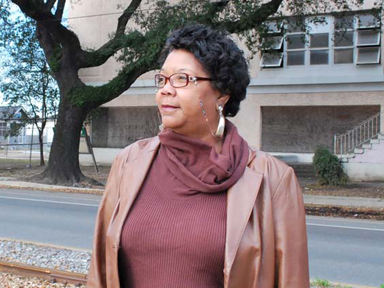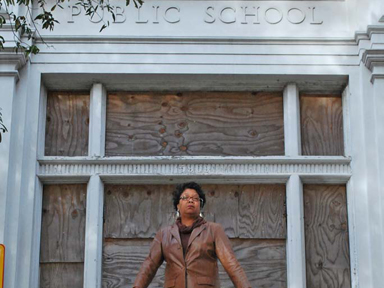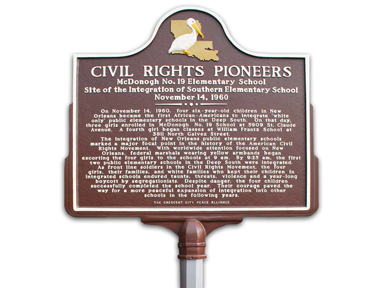|
Hero
Among Us: the
Civil Rights Movement
Through the Eyes of a
Child
 |
| Tessie
hopes her story
helps others see
the beauty of
diversity. |
Tessie Prevost Williams,
administrative assistant
in the Department of
Pediatric Dentistry, has
worked at the LSU School
of Dentistry for 20 years.
She's quiet and
unassuming. You'd never
know that, as a
six-year-old child, she
played a key role in the
history of the civil
rights movement. You'd
never know she was one of
the little girls carefully
chosen by the federal
government to implement Brown
versus Board of
Education, one of
the most important rulings
of the U.S. Supreme Court.
You'd never guess that her
unshakable dignity was
shaped by hatred from
people who didn't know her
and love from the people
who did. This is her
story.
The Test
In 1960, the Orleans
Parish School Board was
under a court order to end
school desegregation. To
do so, 137 black
kindergarten children were
tested to find out who
would be sent to two white
schools. Tessie was one of
those who took the test.
She isn't sure if the test
was meant to measure
intelligence,
psychological resiliency
or something else. What
she does remember is
taking a bus with her
mother from their home in
the Lower Ninth Ward to
the school board
headquarters in Gentilly.
The test took most of the
day.
Weeks later, a Western
Union telegram arrived,
saying she was selected to
attend McDonogh 19
Elementary School, a
school she could see from
her backyard. Her parents
hugged her and told her
she was special. They said
she would meet new people
and that would be good.
First Day
The U.S. marshals who came
to her home to escort her
to the new school were
big, strong men who made
her feel safe. Her father
would come with her, too.
With her hand in his, her
trust was complete.
As they neared the
school, she heard the roar
of the crowd. "I thought
it was a Mardi Gras
parade" she remembers. "I
thought I'd find people
having a good time." She
didn't expect to be
surrounded by hate.
As she, her father, and
the marshals walked up the
school steps, she saw the
police trying to control
the angry crowd. A few
white schoolchildren were
inside the building, but
by the next day, they were
all gone. The children who
stayed were three little
black girls: Tessie
Prevost, Leona Tate, and
Gail Etienne.
"So, there we were, the
only three children in
this empty school
building," Tessie recalls.
The school windows were
taped over with brown
paper to keep out the
world. The schoolyard was
unsafe so the girls jumped
rope and played hopscotch
up and down the hallways.
Tessie remembers the
building as a haven.
Central to her school
life was Mrs. Meyers, her
first-grade teacher. "She
was sweet, with a
wonderful spirit," says
Tessie. "She made us feel
safe and comfortable. She
taught us our school work
and she taught us about
love. I can't imagine how
difficult that time was
for her, a white woman
raised in New Orleans,
teaching black children.
At the end of each day, I
went back to my family and
community where everyone
supported me. What about
Mrs. Meyers? What kind of
support did she have?"
Tessie considers Mrs.
Meyers one of the unsung
heroes of the civil rights
movement in New Orleans.
 |
| Tessie
Prevost Williams
at the site of the
elementary school
where she made
history in 1960. |
Tessie didn't understand
what was happening and was
especially startled to see
herself on the television
news at night. She asked
her grandmother why there
were all those people out
by the school each day.
"Some people are not ready
for change," her
grandmother said. "Don't
you worry; just go to
school and do what you
need to do." Despite the
extraordinary
circumstances, Tessie
received a good education.
"All that attention from
Mrs. Meyers - what a
blessing."
Two years later she was
transferred, along with
Leona and Gail, to T.J.
Semmes School near the
Industrial Canal. It was
an integrated school and
her life quickly
deteriorated. "The white
teachers and students did
not want us there. Every
day there were beatings
and cursing. They spat on
us and ripped off our
clothes." When it was time
for senior high, she had
had enough fighting. She
chose to attend the
all-black Joseph S. Clark
Senior High School.
We Know What You
Did
Johnny Jones, her
eleventh-grade history
teacher, was a teacher
like no other. "He made
history come alive," she
remembers. He assigned
each student a topic and
supervised their research.
Tessie was assigned Brown
versus Board of
Education. She was
stunned to see herself in
the history books.
Her parents gave her
boxes of letters from
people around the world,
praising her courage and
embracing the little girl
who didn't yet appreciate
her place in history.
There was a heartfelt
letter from Eleanor
Roosevelt, widow of
President Franklin
Roosevelt. There was a
photo of Tessie with
Thurgood Marshall, the
legendary civil rights
lawyer who played a key
role in Brown versus
Board of Education
and became a Supreme Court
justice. (See Editor's
Note at End.)
When Tessie talked to
Johnny Jones about her
growing awareness, he
said, "I know who you are.
Every teacher in this
school knows who you are
and we know what you did."
Quickly, she saw the
significance of what
happened to her and the
domino effect of her
childhood…that school
integration led to the
integration of public
facilities, restaurants,
hotels, all the places
where people naturally
gather. Sports historians
know that it was only
after New Orleans
implemented the laws for
open accommodations that
the city was given the
franchise for the New
Orleans Saints.
Today, Tomorrow
Tessie, Gail and Leona
recently did a
presentation about their
experiences to a group in
Baton Rouge. Afterwards, a
white man came up to them.
He said he had driven in
from Covington. His
persona was raw and
honest. "I was one of the
students who taunted you,"
he said. "I spat on you
and called you names. Can
you forgive me and shake
my hand?" The three women
looked at each other and
almost in unison said,
"No. We won't give you a
handshake but we will give
you a hug."
Tessie hopes her story
helps others see the
beauty of diversity. "The
ways that we are different
are things that we should
celebrate. There is so
much power and freedom
when we see differences in
a positive light." It's a
simple truth with a
profound message:
the unique story of
America comes from the
diversity of its people.
 |
| Historical
marker near the
site of the school |
Note: Tessie's
priceless letters and
photos were lost in the
flooding of Hurricane
Katrina.
In celebration of
Black History Month,
Tessie Williams will
speak about her
experiences on Tuesday,
February 15, at noon in
Auditorium A at the
dental school.
|